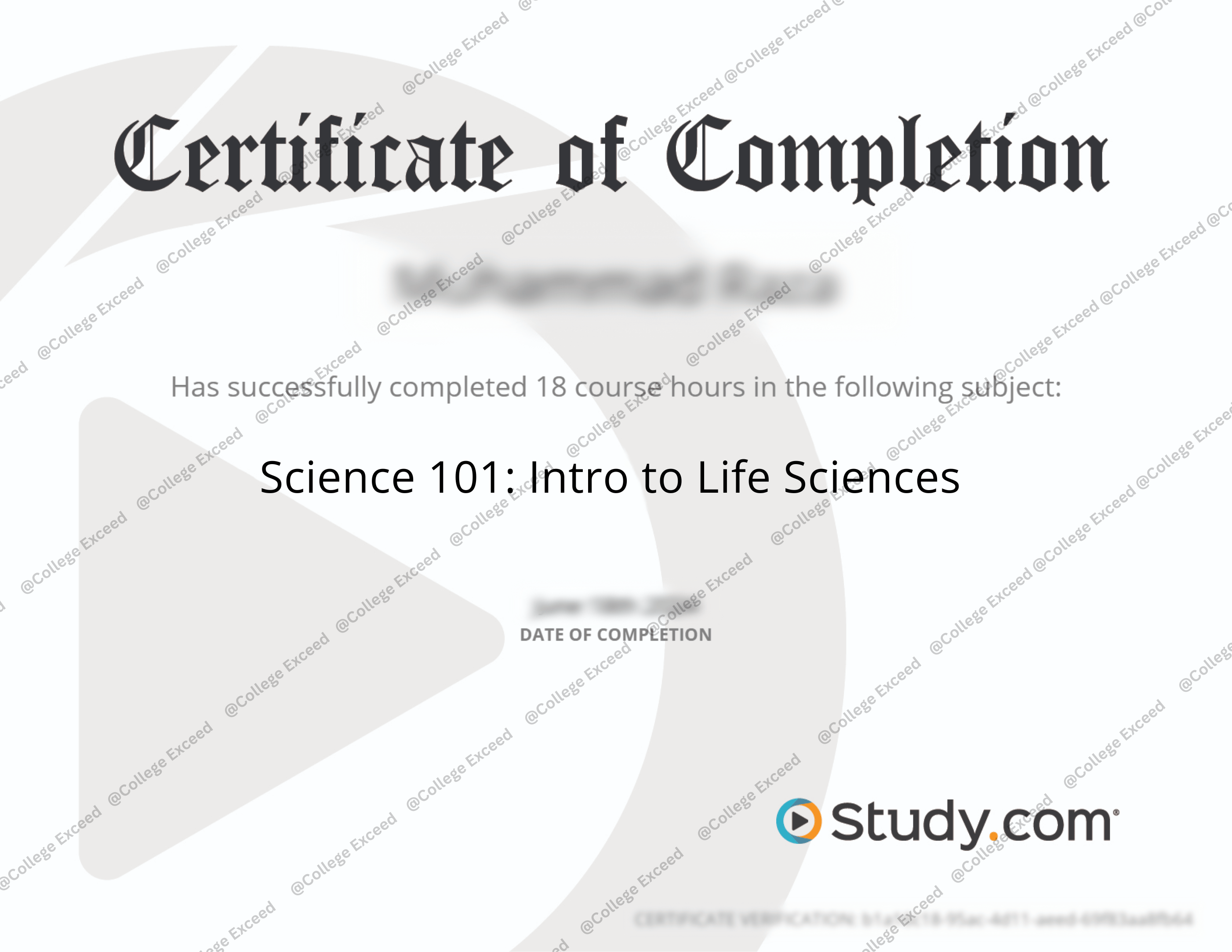
-
Gavin Walton
- November 6, 2024
Greetings to all the would-be students of life sciences! If you’re getting into Study.com and taking its Science 101: Intro to Life Sciences course, then you are on your way towards becoming full-fledged masters of one of the most interesting subjects you will ever come across. This course also introduces you to how life is structured and operated from the lowest organizational level of the cells to the highest organizational level at the ecosystem level on the Earth. So this course is perfect for those who never practiced Science before, as well as for those who need a quick refresher.
What makes Study. As for what makes ‘Science 101: Intro to Life Sciences’ and learning experience so useful, it lies in it’s the way it subjects the difficult material to learning segmented into small chunks. The start of the course will take you from cell biology to genetics, ecology, evolution, and human anatomy, among others, all explained in simple and relatable steps. However, if you are wondering why this looks like a lot then don’t worry! By the time you finish this course, you will have a good understanding of how life functions and, to boot! —and thus prepares you more than adequately to excel on your exam when you get there. Now, let’s get started!
---

Study.com Science 101 FAQ📖
Let us just look at what you will get into when studying Study.com Science 101: Intro to Life Sciences. Let’s break it down. This class is a pretty broad class, but do not let that stress you as it is all for the purpose of providing you with a strong ground in life sciences. Starting from the conception of cell biology to the understanding of systems biology to the understanding of ecology, the biological environment will be exposed to its full interconnection.
You will begin with the basics in Biology which includes Cell Biology and Biochemistry. This is where you’ll comprehend how cells work, how enzymes work, and why DNA is actually so instrumental. You will also be tested on genetics, which will definitely be on the exam, so make sure you’re familiar with the Mendelian inheritance patterns. I assure you that learning about how traits are inherited across generations is important and it’s one of those topics that you are guaranteed to be asked.
Further on the course splits to animal and plant biology, ecology, and the evolutionary mechanisms involved in the development of flying life on the planet. Be ready to review information concerning evolution on the Earth, Darwin’s and Lamarck’s theories, for example. Underlying human body structure and function completes the course’s curriculum. It covers the basic unit of human being and every part of it; from the skeletal system to the nervous system. Focus on this part of the lecture as it shall be part of the test or exam and most probably the last.
By the end of the course, you will know quite a deal about life sciences, which, apart from helping you to pass this particular test, will assist you in perceiving the living world in a different and much broader way. As a reminder, there are concepts that are reviewed frequently and, therefore, those you need to give more focus to; these include natural selection, genetics, and ecology to name but a few. Are you ready to earn good grades in this class? It’s time to proceed to the study plan that will help you to accomplish what has just been mentioned!
Week-by-Week Study Plan to Ace Study.com Science 101 Exam📝
Alright, let’s talk about strategy! To make it easier on you as the student, this course will be broken down week by week so that the student does not get overwhelmed by what is being taught. Below is a compliance checklist intended to help you be prepared for the exam at the completion of the course.
Week 1: Kickoff with the Basics
- Topics to Focus On: Cell Biology, Biochemistry
- What to Do:
- Start with the fundamentals of cell structure and function. Make sure you understand cell organelles and their roles.
- Study enzymes and how they catalyze biochemical reactions—this will be key in later chapters.
- Watch this YouTube video on cell structure to reinforce the material.
- Extra Resource: Go over these Quizlet flashcards on cell biology.
Week 2: Genetics Crash Course
- Topics to Focus On: Mendelian Genetics, Molecular Genetics
- What to Do:
- Dive deep into Mendelian inheritance and the basics of genetic mutations. Pay special attention to Punnett squares—they show up a lot in exams.
- Study DNA structure, replication, and the central dogma of molecular biology (DNA → RNA → Protein).
- Watch this YouTube video on Punnett squares to master the concept.
- Extra Resource: Use this Genetics Quizlet to test your knowledge.
Week 3: Ecosystems and Evolution
- Topics to Focus On: Ecology, Evolution
- What to Do:
- Learn the basics of ecosystems—producers, consumers, and how energy flows through a food web.
- Study natural selection and understand Darwin’s theory. Pay close attention to adaptive traits and how they influence evolution.
- Watch this CrashCourse on Ecology for an overview of ecosystems.
- Extra Resource: Test your knowledge with this Evolution and Ecology Quizlet.
Week 4: Animal and Plant Biology
- Topics to Focus On: Plant Anatomy, Animal Physiology
- What to Do:
- Focus on plant structures like roots, stems, and leaves, and understand their roles in photosynthesis and water transport.
- Dive into animal physiology, specifically the human body systems. Study the skeletal, muscular, and nervous systems in detail.
- Watch this YouTube video on human physiology basics to get a quick overview of body systems.
- Extra Resource: Use this Animal and Plant Biology Quizlet for quick revision.
Week 5: Human Anatomy and Physiology Deep Dive
- Topics to Focus On: Human Body Systems, Circulatory, and Nervous Systems
- What to Do:
- Go deeper into the human circulatory system—understand how blood flows through the heart and why oxygen exchange is vital.
- Study the nervous system. Focus on how signals are transmitted through neurons and how the brain processes information.
- Watch this YouTube video on the circulatory system for a detailed explanation.
- Extra Resource: Go over these Human Anatomy flashcards to reinforce what you’ve learned.
Week 6: Evolution and Phylogeny
- Topics to Focus On: Phylogenetic Trees, Speciation
- What to Do:
- Study how species are classified through phylogenetic trees and how evolutionary relationships are drawn.
- Focus on the processes of speciation and the differences between allopatric and sympatric speciation.
- Watch this YouTube video on speciation for an easy breakdown.
- Extra Resource: Use this Speciation Quizlet for practice.
Week 7: Final Review & Mock Exams
- Topics to Focus On: Recap All Key Topics
- What to Do:
- This is the time to review everything you’ve learned. Go over key concepts like genetics, evolution, human anatomy, and cell biology.
- Take mock tests to simulate exam conditions. Identify your weak areas and focus on improving those before the exam.
- Extra Resource: Take a look at these Study.com Science 101 Mock Exams (if available).
This weekly plan will help you stay organized and avoid cramming at the last minute. Follow it, and you’ll walk into the exam feeling confident!
---
Unlocking Free Tools to Enhance Your Learning Experience📂
- YouTube Channels
CrashCourse:
- One of the best resources for science students! Their playlists on Biology, Ecology, and Anatomy are packed with easy-to-understand explanations, engaging visuals, and just the right amount of humor. They also have an entire series on evolution and genetics.
- Link: CrashCourse Biology Playlist
Khan Academy:
- If you need detailed step-by-step explanations, Khan Academy has excellent lessons on cell biology, molecular genetics, and evolution. Their content is perfect for visual learners who want to break down complex ideas.
- Link: Khan Academy Biology
Amoeba Sisters:
- This channel simplifies complicated biological concepts with fun cartoons. Their videos on genetics, DNA replication, and natural selection are especially helpful and very easy to follow.
- Link: Amoeba Sisters Playlist
- Quizlet
- Study Flashcards & Practice Tests
- Quizlet is your go-to for flashcards, quizzes, and Study sets for cell biology and human anatomy/physiology. The best way to test yourself is to use the ready-made flashcards to revise concepts and their definitions.
- Link: Quizlet Biology Study Sets
- Interactive Websites
BioMan Biology:
- This website is perfect for practicing biology topics interactively! Games and quizzes on topics like ecology, genetics, and evolution, make learning fun and effective.
- Link: BioMan Biology
The Biology Project by the University of Arizona:
- If you want more in-depth practice, this site offers great tutorials and quizzes on key biology topics. It’s like having a free tutor for molecular biology and biochemistry!
- Link: The Biology Project
- Free Textbook Resources
- OpenStax Biology Textbook:
- Fortunately, OpenStax, a non-profit organization that creates free, peer-reviewed textbooks, has you covered with a complete, absolutely sanctioned Biology text that covers everything you’ll be learning in the course.
- Link: OpenStax Biology
- Practice Tests
- Practice Science Tests – ScienceGeek.net:
- If you’re looking for mock exams or practice questions for biology topics, this site is a great resource. They have quizzes on cell structure, genetics, and ecology that mimic exam questions.
- Link: ScienceGeek Practice Tests
---
Essential Concepts That Every Student Should Master🔑
As a way of assisting you so that you can excel in the Study.com Science 101: Intro to Life Sciences exam, let’s go over some concepts that will be especially important to you. To support explanations and mostly to make it easy to understand we will cover elements, give examples, and occasionally use tables to make comparisons easier. Learn these topics and you will be fine coming to the exam!
- Cell Structure vs. Function
It is very important to be able to distinguish between Prokaryotic cells and Eukaryotic cells. Here’s a comparison table to help you visualize the key differences:
Feature | Prokaryotic Cells | Eukaryotic Cells |
|---|---|---|
Nucleus | No nucleus | Has a true nucleus |
Size | Small (1-10 µm) | Larger (10-100 µm) |
Organelles | Few organelles (e.g., ribosomes) | Many organelles (e.g., mitochondria, ER) |
Examples | Bacteria, Archaea | Plants, Animals, Fungi, Protists |
DNA Structure | Circular DNA floating freely in the cytoplasm | Linear DNA within a nucleus |
Tip: Consternating the role and functions of organelles such as mitochondria, an organelle commonly known as the powerhouse of the cell, chloroplast whereby photosynthesis takes place. Of these, some will crop up quite often!
- Photosynthesis vs. Cellular Respiration
Both are presented alongside one another because they are the two ways by which cells generate and utilize energy. Photosynthesis is in plants while respiration is in all other living organisms ranging from animals, plants, and the entire living species. Here’s a simple breakdown:
Feature | Photosynthesis | Cellular Respiration |
|---|---|---|
Purpose | Converts light energy into chemical energy (glucose) | Converts glucose into ATP (usable energy) |
Location | Chloroplasts (in plants) | Mitochondria (in all eukaryotes) |
Reactants | Carbon dioxide, water, light | Glucose, oxygen |
Products | Glucose, oxygen | Carbon dioxide, water, ATP |
Equation | 6CO₂ + 6H₂O + sunlight → C₆H₁₂O₆ + 6O₂ | C₆H₁₂O₆ + 6O₂ → 6CO₂ + 6H₂O + ATP |
Tip: Take note that these processes are interrelated, therefore, during photosynthesis, plants produce glucose which as a result is used to produce energy through cellular respiration.
- Natural Selection vs. Adaptation
A firm grasp of the concept of natural selection is important in the biological sciences. It is the mechanism of how species change with time and a system that ensures that the fittest species resides. Here’s a real-world example:
- Natural Selection: Since I have learned that survival rates depend on the capacity of an organism to fit in the environment, then brown-lined beetles will survive since they are hard to spot. In the process, the brown beetles survive and procreate, therefore increasing the population of brown beetles.
- Adaptation: This is due to that principle which we call ‘survival of the fittest.’ The beetles have evolved to form a brown outer covering (in response to selection pressure) in order to sustain their existence. Adaptations enhance the fitness of the organism within its environment.
- Symbiosis Types
An area of close interdependence of cooperating different species is designated as the symbiotic relations. Here’s a breakdown of the main types of symbiosis:
Type | Definition | Example |
|---|---|---|
Mutualism | Both species benefit | Bees and flowers: Bees get nectar; flowers get pollinated |
Commensalism | One species benefits and the other is neither helped nor harmed | Barnacles on whales: Barnacles get transportation; whales unaffected |
Parasitism | One species benefits and the other is harmed | Ticks on a dog: Ticks feed on blood; dog can get sick |
Tip: It is important for you to look out for some of these interactions specifically in the area of ecosystems and food chains. That is why questions that arise when speaking about symbiosis are usually utilitarian.
If you get to know the following topics well enough, then you will be in a better position to handle many of the questions that relate to the study.com Science 101: Intro to Life Sciences test. Always go back to these concepts and ensure that you repeat the concepts in your head, or even put them in a tabular form or even a diagram.
---
Study.com Science 101 FAQ❓
- In which chapters should I concentrate more if am to do well in the exam?
Pay much attention to Cell Biology & Processes, Evolution & Natural Selection, and Ecology & Ecosystems as they are the most probable to appear in the test. Learning these will put you in a vantage point. - How many hours should I devote to these studies?
They recommend that this should take 4-6 weeks with 2-3 hours of study per day. Adhere to the study schedule so that all required concepts are reviewed. - It concerns me that I am not very good with my use of scientific terminologies. How can I remember them better?
Reviewing, for example, via the use of mnemonics, flashcards, or visuals such as diagrams efficiently consolidates concepts within the learners’ knowledge systems. As for the vocabulary, the primary method is to repeat it to be able to memorize such terms as succession. - Will the exam include diagrams or just multiple-choice questions?
The exam is mostly multiple-choice, but you might need to interpret diagrams or match terms. Be prepared for both types of questions! - What if I don’t understand a topic?
Use free resources like YouTube and Khan Academy to clarify difficult topics. These platforms offer great explanations for complex subjects. - Can I skip some chapters if I’m running out of time?
Focus on the core biology concepts like cell biology, genetics, and evolution. These chapters cover a large portion of the exam.
---
Wrapping Up: How Biology Shapes Our World 📄
All in all, Science 101: Intro to Life Sciences from study.com is your one-stop source to learn about the basics of biology, evolution, and ecology. I want to assure every candidate out there that you don’t need to be a nerd in science to make it in this class if you apply the right strategy. Follow the seven-day-a-week plan strictly, refer to additional materials when necessary, and try to emphasize the main concepts that are often included in tests. Use this guide as your roadmap, and stay consistent with your preparation. Most importantly, keep a positive mindset and tackle each topic step by step. You’ve got this! Good luck with your exam, and happy studying!



